Mecca, also known as Makkah, is a city in the Hejazi region of Saudi Arabia. The city is located 70 km (43 mi) inland from Jeddah in a narrow valley at a height of 277 m (909 ft) above sea level. Mecca is regarded as the holiest city in the religion of Islam and is the birthplace of Prophet Muhammad. If you are a foreigner planning to visit Mecca, the birthplace of Prophet Muhammad and the holiest city in Islam, you may require a visa to Saudi Arabia.
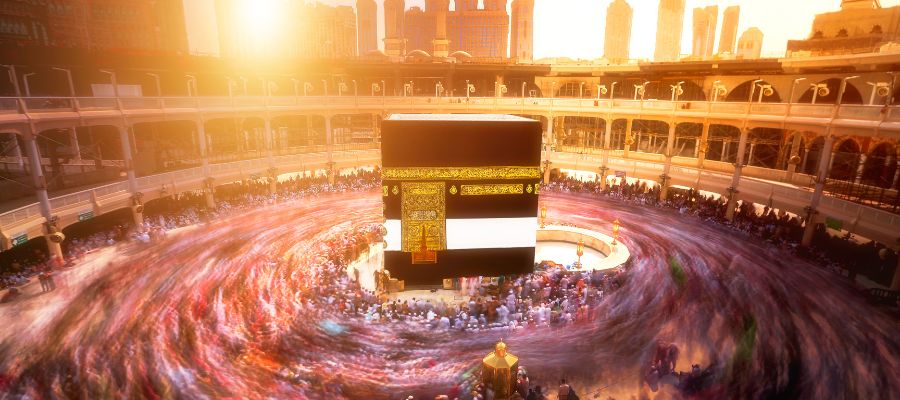
History
Mecca's history is deeply intertwined with the origins and development of Islam. The city's Kaaba, a cube-shaped building at the center of the Grand Mosque, is believed to have been built by Abraham and his son Ishmael, and is the direction of Islamic prayer.
The Prophet Muhammad was born in Mecca in the 6th century and began preaching his revelations there. In 630 AD, Muhammad and his followers conquered Mecca, and since then, it has been the center of the Muslim world.
The Birthplace of Prophet Muhammad
Mecca is famous for being the birthplace of the Prophet Muhammad, the last messenger of Islam. He was born in the year 570 CE in the city, and his birth is considered a significant event in Islamic history. Muhammad's teachings and revelations form the basis of the Islamic faith, making Mecca a place of immense religious importance.
The Kaaba
One of the most prominent symbols of Islam, the Kaaba is located in the center of the Masjid al-Haram (Grand Mosque) in Mecca. Muslims consider it the holiest site on Earth and face towards the Kaaba during their daily prayers, regardless of their geographic location. The Kaaba is a black cube-shaped structure draped in a black cloth known as the Kiswa, which is replaced annually. Millions of Muslims visit the Kaaba during Hajj and Umrah pilgrimages, where they perform Tawaf, circumambulating the Kaaba seven times as an act of worship.
The Hajj
Every year, millions of Muslims travel to Mecca to perform the Hajj, a pilgrimage that is one of the Five Pillars of Islam. The Hajj takes place in the last month of the Islamic lunar calendar, Dhu al-Hijjah, and involves a series of rituals including the Tawaf, in which pilgrims walk seven times around the Kaaba.
Cultural and Economic Significance
Aside from its religious significance, Mecca is also of cultural and economic importance. The influx of pilgrims during the Hajj brings significant revenue to the city and the country. The Saudi government has invested heavily in the infrastructure and hospitality industry in and around Mecca to accommodate the growing number of pilgrims.
The Black Stone
Embedded in the eastern corner of the Kaaba is the Black Stone, a sacred object that holds great reverence among Muslims. According to Islamic tradition, the Black Stone dates back to the time of Prophet Adam and was set into the Kaaba by Prophet Abraham. Pilgrims often strive to touch or kiss the stone during Tawaf, believing it to have the power to absolve sins.
Masjid al-Haram
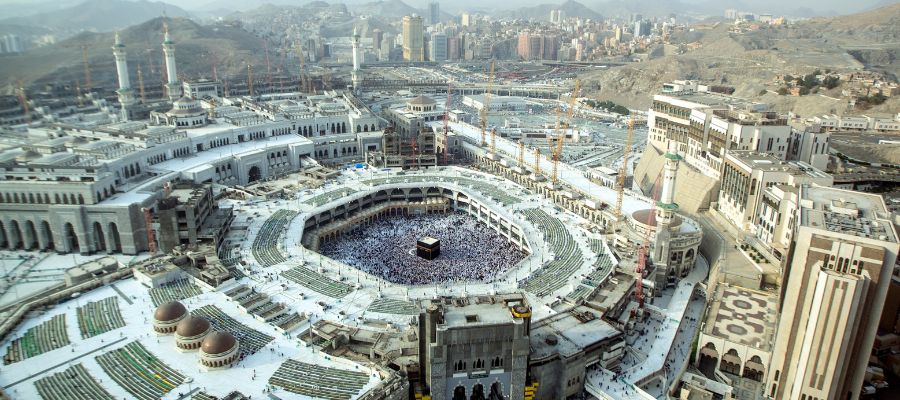
Masjid al-Haram, also known as the Grand Mosque, is the largest mosque in the world and surrounds the Kaaba. It can accommodate millions of worshippers at a time, particularly during the peak periods of Hajj and Ramadan. The mosque features the magnificent Abraj Al Bait Towers, which house luxury hotels and shopping complexes. The expansion of Masjid al-Haram over the years has been aimed at accommodating the increasing number of pilgrims visiting Mecca.
Zamzam Well
Zamzam Well is another renowned landmark in Mecca. According to Islamic tradition, it is believed to be a miraculously generated well that sprang forth when the infant Ishmael, son of Prophet Abraham, was thirsty. The water from Zamzam Well is considered sacred, and pilgrims often collect it to take back home as a blessing. The well is located within the precincts of the Grand Mosque, and its water is available for all visitors.
Modern Mecca
Modern Mecca is a city of contrasts, with skyscrapers and shopping malls standing alongside historic sites. The Clock Tower, for example, is one of the tallest buildings in the world and overlooks the Grand Mosque.
However, the rapid development has also been a source of controversy, with some arguing that it is erasing Mecca's historical and cultural heritage. Despite these concerns, Mecca continues to be a city that is central to the faith and identity of Muslims worldwide.
As the information about Mecca is constantly updated due to ongoing developments and events, it is recommended to refer to recent sources for the most up-to-date information.
Ten Famous Things to Do in Mecca
Mecca, the holiest city in Islam, attracts millions of pilgrims every year who come to perform the Hajj pilgrimage or the Umrah pilgrimage. Besides its religious significance, Mecca also offers several notable attractions and experiences that visitors can explore. Here are ten famous things to do in Mecca:
1. Visit the Masjid al-Haram (Grand Mosque):
The Masjid al-Haram, also known as the Grand Mosque, is the most important site in Mecca. It surrounds the Kaaba, the focal point of Islamic prayer. Pilgrims from all over the world gather here to perform Tawaf, the circumambulation of the Kaaba. The mosque's vast courtyard can accommodate millions of worshippers.
2. Perform the Tawaf:
Performing the Tawaf is a key ritual in Mecca. It involves walking around the Kaaba seven times in a counterclockwise direction. This sacred act symbolizes the unity of Muslims and their devotion to Allah.
3. Safa and Marwa:
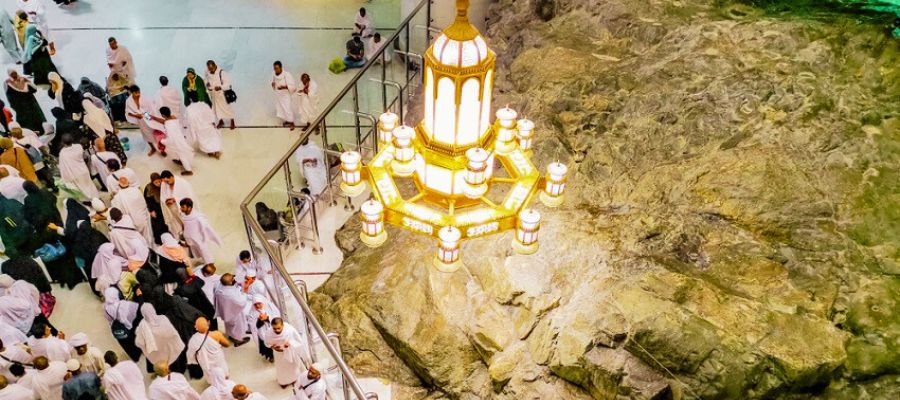
Located inside the Grand Mosque, the hills of Safa and Marwa hold great significance in Islamic history. Pilgrims reenact the footsteps of Hajar, the wife of Prophet Ibrahim (Abraham), who ran between these hills in search of water for her son Ismael. It is customary to walk seven times between the two hills.
4. Visit the Abraj Al-Bait Clock Tower:
The Abraj Al-Bait Clock Tower is a prominent landmark in Mecca. It is one of the tallest buildings in the world and provides breathtaking views of the city and the Grand Mosque. The tower houses a shopping mall, luxury hotels, and a museum showcasing Islamic artifacts.
5. Explore the Zamzam Well:
The Zamzam Well, located in the basement of the Grand Mosque, is a revered water source. Muslims believe that it miraculously appeared to quench the thirst of Hajar and her son Ismael. Pilgrims can drink the holy Zamzam water or take some home as a blessing.
6. Visit the Cave of Hira:
The Cave of Hira is situated on the outskirts of Mecca and holds spiritual significance. It is the place where the Prophet Muhammad received his first revelations from Allah through the angel Gabriel. Many visitors hike to the cave to reflect on this significant event in Islamic history.
7. Explore the Museum of the Two Holy Mosques:
The Museum of the Two Holy Mosques is dedicated to the history and culture of Mecca and Medina. It showcases artifacts, manuscripts, and interactive exhibits that provide insights into the development of Islam and the pilgrimage experience.
8. Discover the Well of Abu Jahl:
Located near the Grand Mosque, the Well of Abu Jahl is believed to be the spot where the disbeliever Abu Jahl was killed during the Battle of Badr. It serves as a reminder of the historical events that shaped the early days of Islam.
9. Visit the Makkah Mall:
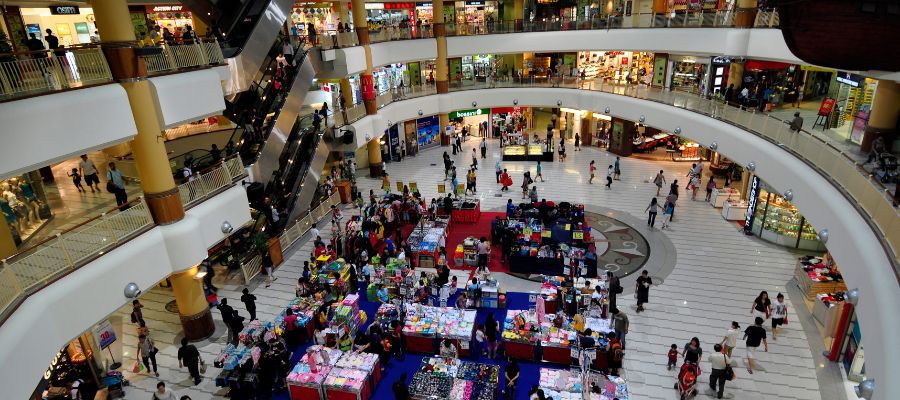
The Makkah Mall is a modern shopping complex where visitors can find a wide range of international and local brands. It offers a variety of retail outlets, restaurants, and entertainment options, providing a break from the religious activities.
10. Enjoy local cuisine:
Mecca offers a diverse range of delicious cuisine. Visitors can indulge in traditional Saudi Arabian dishes like Kabsa (spiced rice with meat), Mandi (slow-cooked meat and rice), and Harees (ground wheat and meat). Exploring the local culinary scene is a delightful experience in Mecca.
Best Places to Visit in Mecca
Mecca, also known as Makkah, is the holiest city in Islam and the birthplace of Prophet Muhammad. Each year, millions of Muslims travel to Mecca to perform the Hajj pilgrimage or the Umrah pilgrimage. Besides its spiritual significance, Mecca offers several fascinating attractions that showcase its rich cultural and historical heritage. Here are some of the best places to visit in Mecca:
1. Masjid al-Haram (Great Mosque)
The Masjid al-Haram is the most important and iconic site in Mecca. It is the largest mosque in the world, with the Kaaba at its center. Muslims face the Kaaba when performing their prayers, and during the Hajj, pilgrims walk around the Kaaba seven times. The mosque can accommodate millions of worshippers, and its magnificent architecture, intricate decorations, and sheer grandeur make it a must-visit destination.
2. Kaaba
The Kaaba is a small, cube-shaped building located within the premises of the Masjid al-Haram. It is the holiest site in Islam and is believed to have been built by the Prophet Ibrahim (Abraham) and his son Ismail (Ishmael). Muslims from all over the world face the Kaaba during their daily prayers. The building is covered in a black cloth embroidered with gold, called the Kiswah, which is replaced annually.
3. Abraj Al Bait Clock Tower
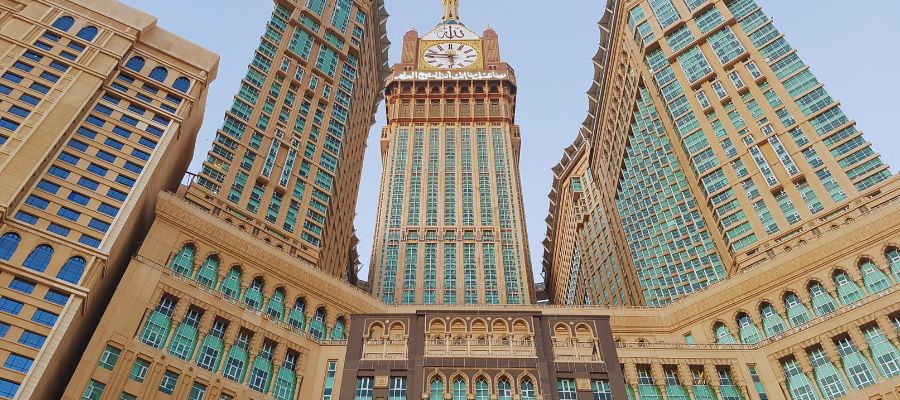
Located adjacent to the Masjid al-Haram, the Abraj Al Bait Clock Tower is a stunning skyscraper complex that houses luxury hotels, shopping malls, and other amenities for pilgrims. It is one of the tallest buildings in the world and is recognizable by its clock face, which is one of the largest in the world. Visitors can enjoy panoramic views of Mecca from the observation deck on the top floor.
4. Zamzam Well
The Zamzam Well is a sacred well located within the Masjid al-Haram complex. It is believed to have been miraculously created by Allah to provide water to Hajar (Hagar) and her son Ismail when they were stranded in the desert. Pilgrims often drink from the Zamzam Well and collect its water as a blessed souvenir.
5. Mount Arafat
Located about 20 kilometers east of Mecca, Mount Arafat is a significant landmark during the Hajj pilgrimage. It is the place where the Prophet Muhammad delivered his final sermon. Pilgrims gather on the plains of Arafat on the 9th day of the Islamic month of Dhu al-Hijjah, which is the most important day of Hajj. Standing on Mount Arafat is considered a crucial ritual during Hajj.
6. Mina
Mina is a tent city located a few kilometers east of Mecca. During the Hajj pilgrimage, pilgrims stay in Mina and perform symbolic rituals such as stoning the devil by throwing pebbles at three pillars. The tent city is a bustling hub during Hajj and offers a glimpse into the unique experience of millions of pilgrims coming together for this spiritual journey.
7. Quba Mosque
Quba Mosque is the first mosque built by Prophet Muhammad after his migration from Mecca to Medina. Though it is located in Medina, it is a popular site to visit while in Mecca. Muslims often stop at Quba Mosque to offer prayers and seek blessings. The mosque's beautiful architecture and serene atmosphere make it a peaceful place for worship.
8. Jannat al-Mu'alla
Jannat al-Mu'alla is an ancient cemetery located in Mecca. It is the resting place of several important figures from Islamic history, including the Prophet Muhammad's wife, Khadijah, and other close companions. Many visitors pay their respects and offer prayers at this historic cemetery.
These are just a few of the many remarkable places to visit in Mecca. The city's deep-rooted religious significance, combined with its rich history and awe-inspiring architecture, make it a truly unforgettable destination for Muslims and non-Muslims alike.
Best Time to Visit Mecca
Mecca, located in the Kingdom of Saudi Arabia, holds immense religious significance as the birthplace of the Islamic prophet Muhammad and the holiest city in Islam. Each year, millions of Muslims from around the world undertake the Hajj pilgrimage to Mecca, while Umrah (a lesser pilgrimage) is performed throughout the year. If you are planning a visit to Mecca, it is important to consider the best time to ensure a fulfilling and comfortable experience. Here are some key factors to consider when determining the best time to visit Mecca:
1. Climate and Weather:
Mecca is situated in a desert region, and its climate is characterized by extremely high temperatures, especially during the summer months. The city experiences scorching heat, with temperatures often exceeding 40°C (104°F) from May to September. The best time to visit Mecca is during the cooler months, particularly between November and February when temperatures are relatively mild and range between 20°C to 30°C (68°F to 86°F).
2. Hajj and Umrah Seasons:
Hajj is the annual Islamic pilgrimage that takes place during the last month of the Islamic lunar calendar, known as Dhu al-Hijjah. It is a significant event in Mecca, and millions of pilgrims gather during this time, resulting in overcrowding and high accommodation costs. If you wish to participate in the Hajj pilgrimage, then the best time to visit Mecca is during the Hajj season. However, if you prefer a less crowded experience, it is advisable to plan your visit during other months of the year, outside the Hajj season.
Umrah can be performed throughout the year and is not limited to specific months. However, certain periods witness increased Umrah activity, such as Ramadan (the holy month of fasting for Muslims) and the school holidays in various countries. During these times, Mecca experiences higher numbers of pilgrims, leading to busier streets and longer waiting times at religious sites.
3. Ramadan:
Ramadan is an auspicious month for Muslims, during which fasting from dawn till sunset is observed. Many Muslims choose to perform Umrah during Ramadan, as it is believed to be a particularly blessed time. If you are interested in experiencing the unique atmosphere of Mecca during Ramadan, it can be an excellent time to visit. However, keep in mind that some services and facilities may operate at different hours due to the altered daily routine during the month.
4. Accommodation and Cost:
The demand for accommodation in Mecca is high throughout the year due to the continuous flow of pilgrims. However, prices tend to surge during peak periods, such as Hajj and Ramadan. If you are on a budget, it is advisable to plan your visit during the off-peak season when rates are relatively lower. Additionally, booking your accommodation well in advance can help secure better deals.
5. Local Festivals and Events:
Mecca hosts several local festivals and events, which can add cultural richness to your visit. One notable event is the Mecca Cultural Forum, which takes place annually and features various artistic and cultural activities. Researching and aligning your visit with such events can enhance your overall experience.
How to Reach Mecca from Medina: A Guide for Pilgrims
Performing Hajj or Umrah, the Islamic pilgrimages, involves visiting both Medina and Mecca. Medina is the second holiest city in Islam, and it serves as a starting point for many pilgrims before proceeding to Mecca, the holiest city. This guide provides detailed information on the various modes of transportation available for traveling from Medina to Mecca.
1. Distance and Time:
The distance between Medina and Mecca is approximately 449 kilometers (279 miles) by road. The journey usually takes around 4 to 5 hours, depending on traffic and road conditions.
2. Modes of Transportation:
There are three primary modes of transportation for pilgrims traveling from Medina to Mecca: by road, by air, and by train.
Road Transportation:
- The most common and convenient way to travel from Medina to Mecca is by road. Pilgrims can choose from the following options:
- Private Vehicles: Pilgrims who prefer flexibility and independence can rent a car or hire a private vehicle to travel between the two cities. Several car rental agencies are available in both Medina and Mecca, offering a range of vehicles to suit different needs.
- Shared Taxis: Shared taxis, also known as "service taxis" or "Hajj taxis," are a popular choice among pilgrims. These taxis operate on fixed routes and can be found near major transportation hubs and popular pilgrimage sites. Shared taxis offer a cost-effective option for transportation and allow pilgrims to share the journey with fellow travelers.
- Buses: Several bus companies provide scheduled services between Medina and Mecca. These buses are comfortable and equipped with air conditioning, making them a reliable and affordable mode of transportation. Tickets can be purchased in advance or at the bus terminals.
Air Transportation:
- For those who prefer a quicker and more convenient option, air travel is available between Medina and Mecca. The journey by air takes approximately one hour. Several domestic airlines operate daily flights between the two cities, with multiple departures throughout the day. It is advisable to book flights in advance, especially during peak pilgrimage seasons.
Train Transportation:
- The Haramain high-speed train, also known as the Mecca-Medina high-speed railway, provides a fast and comfortable option for pilgrims. The train connects Medina with Mecca and several other major cities in Saudi Arabia, such as Jeddah and King Abdullah Economic City. The journey between Medina and Mecca by train takes approximately two hours. The train stations are conveniently located near the Holy Mosque in both cities, making it a popular choice for pilgrims.
3. Important Considerations:
When planning the journey from Medina to Mecca, pilgrims should keep the following considerations in mind:
- Visa Requirements: Ensure that you have the necessary visas and travel documents required for entry into Saudi Arabia. Obtain the appropriate visas well in advance to avoid any last-minute complications.
- Traffic Conditions: Road travel between Medina and Mecca can be congested, especially during peak pilgrimage seasons. It is advisable to plan the journey accordingly, considering the potential traffic delays and allow for extra travel time.
- Weather Conditions: The weather in Saudi Arabia can be hot and dry, particularly during the summer months. Stay hydrated and dress appropriately for the weather conditions, especially if traveling by road.
- Religious Customs: Familiarize yourself with the religious customs and practices associated with traveling to Mecca. Respect the local traditions and observe the guidelines set by the authorities.
Conclusion:
Traveling from Medina to Mecca is an integral part of the Hajj and Umrah pilgrimage. Pilgrims have several transportation options available, including road travel, air travel, and train travel. It is important to plan the journey in advance, considering factors such as visa requirements, traffic conditions, weather, and religious customs. By following this guide, pilgrims can reach Mecca from Medina smoothly and embark on their spiritual journey.
Best Places for Shopping in Mecca
1. Abraj Al Bait Mall (Clock Tower Mall)
- Located within the iconic Abraj Al Bait complex, this mall is one of the largest and most popular shopping destinations in Mecca.
- Offers a wide range of international and local brands, including fashion, accessories, electronics, and more.
- Features numerous luxury boutiques and high-end stores.
- The mall is also home to a variety of dining options and a food court.
- Provides stunning views of the Masjid al-Haram and the Kaaba.
2. Souk Al-Zal (Zal Market)
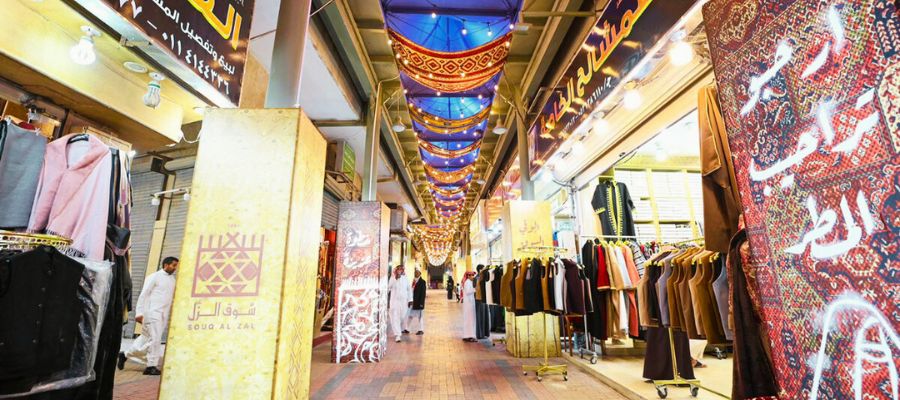
- Situated near the Masjid al-Haram, this traditional market offers an authentic shopping experience.
- Specializes in selling Islamic merchandise such as prayer mats, clothing, books, and religious artifacts.
- Provides a vast selection of perfumes, oud, and attar, which are popular souvenirs from Mecca.
- Bargaining is a common practice here, so visitors can try to negotiate prices.
3. Al Diyafa Mall
- Located in the Al Diyafa Hotel, this mall is known for its upscale shopping experience.
- Features a wide range of luxury brands, including renowned fashion labels, jewelry, and accessories.
- Offers a selection of high-quality dates, a popular local product.
- Provides a comfortable and air-conditioned shopping environment, ideal for escaping the heat.
4. Al Hijaz Mall
- Situated in the Al Aziziyah district, this mall is a favorite among locals and visitors alike.
- Offers a mix of international and local brands, including clothing, accessories, electronics, and household items.
- Features a spacious food court and various restaurants offering both local and international cuisine.
- Provides ample parking space and easy access to public transportation.
5. Makkah Mall
- Located in the Al Aziziyah district, this modern shopping center caters to a diverse range of shoppers.
- Offers a variety of shops, including clothing, footwear, cosmetics, electronics, and home goods.
- Features a supermarket, making it convenient for grocery shopping.
- Provides entertainment options such as a cinema complex and a children's play area.
6. Jabal Omar Shopping Center
- Situated within the Jabal Omar development, this shopping center offers a mix of retail and dining options.
- Features a range of international and local brands, catering to different budgets.
- Provides a comfortable and modern shopping environment, with air conditioning and spacious walkways.
- Conveniently located near several hotels, making it easily accessible for visitors.
It is worth noting that shopping hours in Mecca may vary during the holy month of Ramadan and other religious occasions. Visitors are advised to check the operating hours of the malls and markets beforehand.
Mecca's Famous Food
Mecca, the holiest city in Islam and the birthplace of the Prophet Muhammad, is not only known for its religious significance but also for its rich culinary heritage. The city offers a wide array of delicious and traditional dishes that are deeply rooted in Arabian cuisine. From aromatic spices to succulent meats, Mecca's famous food is a delightful blend of flavors and textures that captivate the taste buds of both locals and visitors alike. In this article, we will explore some of the most iconic dishes that make Mecca a gastronomic paradise.
1. Mandi: A Royal Delight
Mandi is perhaps the most famous dish associated with Mecca. This traditional Arabian delicacy consists of tender and flavorful meat (usually lamb or chicken) that is slow-cooked with a blend of aromatic spices, including cardamom, cloves, and cinnamon. The meat is then placed on a bed of fragrant basmati rice, garnished with roasted nuts and raisins, and served with a side of tangy tomato sauce or yogurt. The combination of tender meat, fragrant rice, and aromatic spices makes Mandi an absolute must-try when visiting Mecca.
2. Kabsa: A Flavorful Rice Dish
Kabsa is another popular rice dish that originates from the Arabian Peninsula and has become a staple in Mecca's culinary scene. It features long-grain rice cooked with a medley of spices, such as saffron, black lime, and black cardamom, which infuse the rice with a distinct aroma and flavor. Kabsa can be prepared with various proteins like chicken, lamb, or fish, and often includes an assortment of vegetables and nuts. The dish is usually garnished with fried onions and served with a side of tangy tomato sauce or raita (yogurt-based condiment).
3. Harees: A Hearty Porridge
Harees is a traditional Arabian dish that has been savored in Mecca for centuries. It is a simple yet hearty porridge made by slow-cooking a mixture of wheat and meat (usually chicken or lamb) until it reaches a creamy and smooth consistency. The dish is delicately spiced with flavors like cinnamon and nutmeg, which add warmth and depth to the overall taste. Harees is often enjoyed during special occasions and religious festivals, such as Ramadan, and is served with a drizzle of ghee (clarified butter) and a sprinkle of cinnamon on top.
4. Saleeg: Creamy Comfort Food
Saleeg is a comforting and creamy rice dish that has its roots in Mecca's culinary traditions. It consists of slow-cooked rice simmered in a flavorful broth made with chicken, spices, and milk. The long cooking process allows the rice to absorb the flavors of the broth, resulting in a creamy texture and a rich taste. Saleeg is commonly served with tender chicken or lamb on top and garnished with fried onions, toasted almonds, and a sprinkle of ground cinnamon, adding an irresistible touch to the dish.
5. Mutabbaq: A Flaky Pastry Delight
Mutabbaq is a popular street food in Mecca, loved for its flaky and crispy texture. It is a stuffed pastry that can be sweet or savory. The savory version typically features a filling of minced meat, onions, and a blend of aromatic spices, while the sweet variant is filled with a mixture of nuts, sugar, and fragrant spices like cardamom. Mutabbaq is then folded into a triangle or square shape and deep-fried until golden brown. It is best enjoyed while still warm, either as a snack or as a light meal.
In conclusion, Mecca offers a diverse and mouthwatering selection of dishes that reflect the rich culinary heritage of the region. Whether it's the aromatic Mandi, flavorful Kabsa, hearty Harees, creamy Saleeg, or the delightful Mutabbaq, these famous foods of Mecca will surely leave a lasting impression on your taste buds. Exploring the local cuisine while visiting Mecca is an essential part of experiencing the city's vibrant culture and traditions.
To obtain a Saudi Arabia
- Step1: Complete the online application by providing your passport details.
- Step2: Submit payment online using a credit card.
- Step3: Monitor your email for confirmation of payment and receipt of your eVisa, which will be sent electronically.
Recent News
- Saudi Tourism Authority and Trip.com Group sign global agreement to significantly boost tourism numbers
- WTTC celebrates Saudi Arabia milestone surpassing 100 million tourists
- 2024 Ramadan Celebration in Saudi Arabia
- Saudi Arabia Unveils Expo 2030 Visa Initiative
- 5 NEW Visas to Work & Live in Saudi Arabia! (Expats Guide)
- Saudi Arabia's Innovative Residency Programs for Foreign Talent and Investment
- Saudi Arabia Investor Visa Open to All Nations
- Turkey Visa for Saudi Arabia
- Saudi Arabia Expands eVisa Program to 6 Additional Nations
- Verify Your Saudi Visa Application Status
